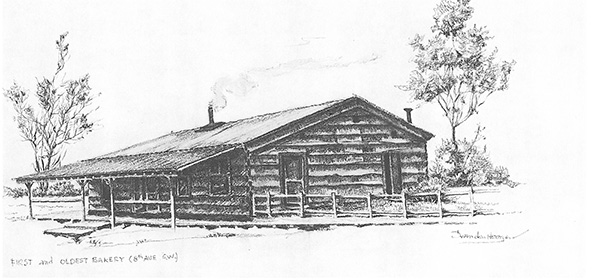
Aug. 03, 2012 | CREBNow
From Stephen Avenue to Heritage Park
When touring the sights at Heritage Park, the building dedicated to the life of early Calgary resident W.G. MacKay might look like any other log cabin. However, the small building has gone through several incarnations, including serving for a time as a Calgary bakery."Our records state the cabin was built in approximately 1884 or '85 out of logs salvaged from an abandoned mine," said Barb Munro, communications specialist for Heritage Park. "Possibly at Silver City near Banff, and floated down the Bow River.
From what Heritage Park was able to dig up, the cabin was built by William Bruce and originally located at 8th Avenue and 3rd Street SE. For a time it was rented out to the MacKay family before serving as the Log Cabin Bakery between 1906 and 1914.
"Heritage Park acquired the building in 1964 where it served as a combination barber shop and harness shop, print shop and as the Log Cabin Bakery," said Munro. "It was moved into the Settlement area of the park in 1976 where it was revived into its role as a residence and is now known as the MacKay Cabin.
Not much is known of W.G MacKay other than he was an early Calgary resident and jack-ofall- trades including taxidermist, naturalist and furrier. MacKay was included in the 1888 Calgary Herald Newspaper Abstracts, "J.W. Cockle, having left Calgary, all orders in the taxidermist line, will now be attended to by W.G. MacKay in the old stand, Stephen Avenue."
The street was named for the first president of the Canadian Pacific Railway, George Mount Stephen in 1884, the same year, or close to, the log cabin that would become the Log Cabin Bakery was built.
Stephen Avenue today faintly resembles itself as it did between 1880 and 1930 when most of the buildings were constructed. In 1886 a fire destroyed 70 of the wooden buildings in downtown Calgary causing council to pass a law requiring all public buildings be made from fireproof materials such as brick and the local Paskapoo sandstone.
With the increasing costs of sandstone, failure of quarries to supply desirable stone and competition from other building materials, quarries in the area closed, and with the outbreak of the First World War, Calgary's Sandstone Era came to an end with some construction projects on Stephen Avenue left uncompleted.
When the Great Depression hit in the 1930s, despite the poor world economy banks continued to be constructed on Stephen Avenue including the Bank of Montreal and the Bank of Nova Scotia. Then, in the '40s, oil was discovered in Leduc and the oil boom brought prosperity both to Alberta and Calgary and J.B Barron began construction on The Barron Building, an office tower on 8th Avenue and 5th and 6th Street SW, a hub for oil companies to move to the city.
In 2002, a portion of Stephen Avenue was declared a national historical site by the Federal Government with about three dozen buildings recognized.
Tagged: Calgary Community | Calgary Real Estate | Calgary Real Estate News | Heritage




